Leonid Anisimovich Tkachenko was a Soviet and Russian painter. A member of the Saint Petersburg Union of Artists, he lived and worked in Saint Petersburg, regarded as one of the leading representatives of the "left" wing of the Leningrad school of painting.
Stepan Ivanovich Privedentsev was a Soviet Russian painter, a member of the Leningrad Union of Artists, who lived and worked in Leningrad, regarded as one of representatives of the Leningrad school of painting, most famous for his genre and landscape paintings.
Anatoli Pavlovich Levitin was a Soviet Russian painter and art educator, People's Artist of the Russian Federation, a member of the Saint Petersburg Union of Artists, who lived and worked in Saint Petersburg and Krasnoyarsk, regarded as one of representatives of the Leningrad school of painting, most famous for his genre and portrait paintings.

Freemasonry in Russia started in the 18th century and has continued to the present day. Russian Freemasonry pursue humanistic and educational purposes, but more attention is given to ethical issues. It was a spiritual community of people united in an effort to contribute to the prosperity of the Motherland and the enlightenment of the people living in it.
Lia Alexandrovna Ostrova was a Soviet Russian painter, graphic artist and art teacher, a member of the Saint Petersburg Union of Artists, who lived and worked in Leningrad - Petersburg. Lia Ostrova regard as one of representatives of the Leningrad school of painting.

Vladimir Evgenievich Malevsky was a Soviet Russian painter and graphic artist, a member of the Leningrad Union of Soviet Artists, who lived and worked in Leningrad. Vladimir Malevsky regard as one of representatives of the Leningrad school of painting.
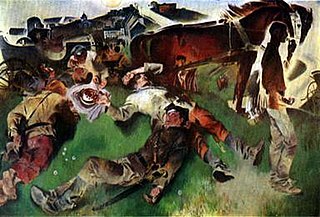
Cherry is an oil painting on canvas painted in 1969 by Russian artist Yevsey Moiseyenko (1916–1988).
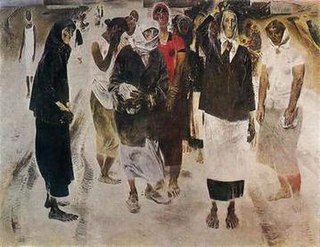
Mothers, Sisters is a 1967 painting by Russian artist Yevsey Moiseyenko (1916–1988).
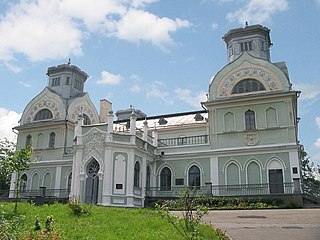
The Lopukhin family was a noble family of the Russian Empire, forming one of the branches of the Sorokoumov-Glebov family.
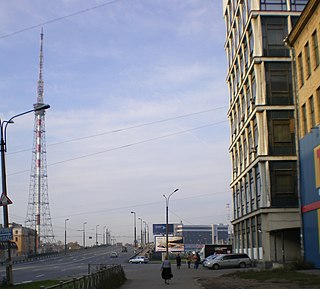
Kantemirovskiy Bridge is a large modern drawbridge in Saint Petersburg, Russia across the Bolshaya Nevka arm of the Neva river. The bridge connects the northern Aptekarsky Island of the north-central Petrogradsky District on Petrograd Side with northeastern Vyborgskiy District of the city and over it with the northeast and east of Saint Petersburg. It receives automobile traffic from Bolshoy Prospekt via Prospekt Medikov in the southwest and takes it to Kantemirovskaya Street on the right-hand riverside, after which it was named. The street itself was named in 1952 after the railway station of a settlement of Kantemirovka in Voronezh region which was liberated from Nazi Germany troops by the Soviet Red Army in December 1942. The settlement in its turn was named after its 18 century owner Dimitrie Cantemir and his brother Constantin, Moldavian princes given shelter in Russia after a military defeat and entered into Russian nobility.
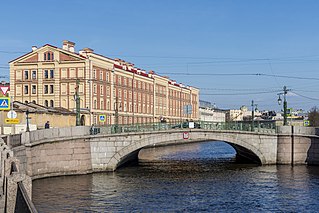
Mogilyovsky Bridge is a bridge across the Griboyedov Canal to Admiralteysky District of Saint Petersburg that connects Kolomensky and Pokrovsky Islands. This bridge is located along the Lermontovsky Avenue axis. It is near the Estonian Orthodox Brotherhood St. Isidor's Church which was built in 1903—1907 by architect Alexander Poleshchuk. Upstream from Mogilyovsky Bridge is Pikalov Bridge; below is Alarchin Bridge. The closest metro station is 1.6 км away and is called Sadovaya.

Staro-Kalinkin Bridge is a bridge across the Fontanka River in Admiralteysky District, Saint Petersburg. It connects Kolomensky and Bezymyany Islands. Along with Lomonosov Bridge it is one of 7 stone three-span bridges across the Fontanka built in the 1780s, which have survived to this day.

Smezhny Bridge is a bridge across the Kryukov Canal in the Admiralteysky District of Saint Petersburg that connects the Spassky and Pokrovsky Islands.

Kryukov Canal is one of the canals in central Saint Petersburg, Russia.

Staro-Nikolsky Bridge spans the Kryukov Canal in the Admiralteysky District of Saint Petersburg, Russia. It connects the Spassky and Pokrovsky Islands. It is a monument of history and culture.

The Kashin Bridge is a hingeless vault bridge across the Kryukov Canal in the Admiralteysky District of Saint Petersburg, Russia. The bridge connects Kolomensky and Kazansky Islands.

The Dekabristov Bridge is a steel girder bridge across the Kryukov Canal in the Admiralteysky District of Saint Petersburg, Russia. The bridge connects the Kolomensky and Kazansky Islands. It is a monument of history and culture.
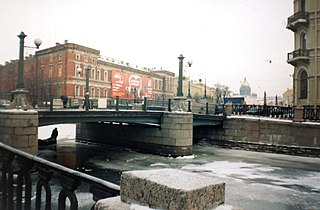
Matveevsky Bridge — is a steel girder bridge over the Kryukov Canal in the Admiralteysky District of Saint Petersburg, Russia. It connects the Kolomensky and Kazansky Islands. The bridge has retained the architectural appearance characteristic of the bridges of the Kryukov Canal during the 1780s. It is a monument of history and culture.

Kronverksky bridge is a bridge over the Kronverksky Strait in the Petrogradsky District of Saint Petersburg, Russia.
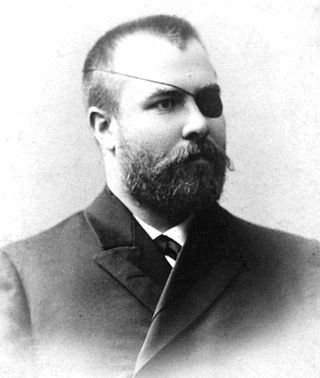
Matvey Kuzmich Lyubavsky was a Russian and Soviet historian, professor, academic and rector of the Moscow University from 1911 to 1917.

















